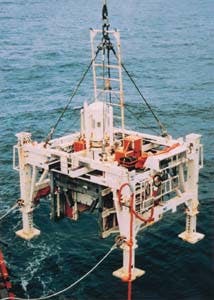Weighing around 50 tons, SubSea Offshore's free-standing habitat is lowered into the Taranaki Bight. The pod on top of the habitat is the weld power source for the Otto automated hyperbaric system.
Following completion this May of a biennial pipeline weld for Tokyo Gas, Aberdeen-based SubSea Offshore's automatic orbital TIG system (Otto) remains in the forefront of welding technology.
A proprietary development by the company, Otto is an automated hyperbaric precision welding system capable of operating at depths down to 625 meters. Quality and precision of welds are maintained by accurate control of all operational parameters, including real-time surface displays of welding arcs and logging of progress.
The system, which has been widely used in Norway and the US for tie-in of 10, 16, 20, 24 and 36-in. pipelines, can also be deployed with virtually any standard habitat and alignment system.
One of Otto's most challenging applications to date has been the hyperbaric welded tie-in on stainless steel clad pipe for the Maui gas pipeline project in the Taranaki Bight off the New Zealand coast. Completed at depths of 110 metres, the venture also called for pioneering use of a plastic tent around the weld area within a 50 ton subsea habitat.
Following laying of a 20-in. diameter pipe along the 15 km route between the Maui A and B platforms by main contractor Heeremac (acting for Shell Todd Oil Services), SubSea Offshore was retained to tie in the line at its platform bases.
A primary concern affecting choice of the Otto system was the somewhat unusual nature of the pipeline. Comprising 28mm WT carbon steel with a 3mm inner cladding of stainless steel, its composition was dictated by the highly corrosive nature of sour gas scheduled to be carried. This in turn precluded ingress of seawater during tie-in operations since any resulting corrosion of its lining would clearly have an adverse effect on the pipeline's planned purpose and longevity.
A secondary consideration was possible coking contamination between the two steels during welding operations, implying that hyperbaric welds would have to be completed in a dry environment.
As a result, it was concluded that the best way to prevent oxidation of root faces was to install a heat-resistant gas-proof tent over the TIG welder, purged with argon to minimize oxygen contamination and so providing a safer environment for normal manned work. The plastic tent was therefore enclosed within Otto's main habitat chamber.
Prior to welding, land areas between steels had to be hand-filled and filed back to required tolerances. The welding process itself entailed pairs of hyperbaric welds at each platform location by connecting a 70 meters long spoolpiece to the riser at one end and to the main pipeline at the other.
Ensuring untreated salt water did not enter the pipe was achieved at the riser by making the weld prep at the base of the riser tube turn inside Otto's habitat after it was blown dry and sealed off with an inflatable plug while spool ends were raised into it. The habitat's door was then sealed around the spool and its confines blown dry for fine alignment of the spool/riser prior to welding.
Following welding, NDT and wrapping of exposed pipes, the habitat was derigged and shifted to the pipeline end of the spool. To minimize welding fit-up problems, a selected pipe joint of the best out of round tolerance had been fitted into the pipeline at each tie-in location. The pipeline was subsequently raised into the habitat which was then blown dry.
The pipeline was cut, and its ends separated sufficiently for installation of an inflatable pig while the habitat was flooded prior to lowering of the pipeline start-up end to the seabed and subsequent recovery by a DSV. The already prepped spool end was then raised into the habitat, the door sealed around it and the habitat blown down for fine alignment and welding.
This project, performed in particularly inclement weather conditions, marked the first-ever production hyperbaric welding operation applied to stainless steel clad pipe offshore, according to SubSea Offshore.
Copyright 1995 Offshore. All Rights Reserved.




